3 August, 2001
Drilling for ice cores - Eric Steig and Meredith Galanter
This afternoon I accompanied Eric Steig of the University of Washington
on an adventure to drill a small ice core. Eric's big project here is
"year-round samples of water vapor for analysis of stable isotopes". He
has some vapor traps that use methanol to cool water vapor in traps with
glass beads. He then uses suction to remove the vapor and looks at the
ratios of the isotopes of Oxygen in the atmosphere. This information
about our current atmospheric content and its relationship to temperature
will help to confirm the Oxygen records that are stored in the ancient
ice cores. Each year, Eric returns to Summit and drills a small ice core
to analyze. Since the weather was calm, clear and warm today, it seemed
like a good day to drill for an ice core.
This ice core that Eric drilled today will also be used by Meredith of
Princeton University's atmospheric chemistry department. She is looking
for the by products of acid rain, the NO3 groups. Meredith Galanter is
a graduate student pursuing her Ph.D. at Princeton University. She is
studying atmospheric chemistry in the Department of Geosciences at
Princeton. She is collecting snow and ice core samples this summer to
look at the nitrogen and oxygen isotopes of nitric acid (HNO3). HNO3 is a
component of acid rain and its concentrations in snow in Greenland have
increased since the Industrial Revolution because of pollution throughout
the Northern Hemisphere. Nitrate (the ionic form of HNO3) concentrations
have long been measured and studied in ice cores, however it has been
difficult to utilize this information. Nitrate is a "reversibly-
deposited" species and its concentrations are impacted after it has been
deposited on the snow by, for instance, photolysis and sublimation.
Meredith hopes that the isotopes of nitrate will provide more information
about the chemical reactions that took place before and after the nitrate
was deposited on the snow. Ultimately she would like to use this
information to say something about past atmospheric chemistry,
parcticularly between the change from pre-industrial to post-industrial
times. This was her first ice core experience. Eric was teaching her
how to take ice core, and like everything else I have experienced here,
what seemed pretty straight forward on the surface was actually a little
tricky.
I helped with the assembly of the coring mechanism and the drilling of
the core .
It took from 2-6 pm to sample four meters of core. Eric plans to return
tomorrow to sample another ten meters of core. Later this week, Meredith
also plans to sample the atmosphere and snow for the NO3 ion.
Saturday August 4th - update on this coring project.
Eric and Meredith did return to their core project today. They took along
a generator and an engine to help with the coring process. It was all
going very well, until, at nine meters down, the drill bit warmed the ice
too much and froze into the snow. At dinner tonight everyone had their
ideas for how we could get this drill out. Last year another drill was
lost in the same way, by a different group of scientists. These drills
cost anywhere from five to ten thousand dollars.
Many people have volunteered me to dig a nine meter pit, in order to
recover the drill. I actually would like the challenge of seeing if we
could do it. It could be dangerous digging that deep (27 feet) because
the snow could collapse. Others are suggesting hot water in the hole, a
tractor to pull it out or hot air down the hole. I don't think we are
going to leave this drill here. It could be the next ingenuity test!
Sunday August 12th - the final chapter of the drill rescue saga
With the rest of the science projects packed away, it was time to return
once more to the drill rescue mission for some entertainment. Earlier in
the week, Larry, Meredith and Eric used a giant hot air blower, called a
herman - nelson, to melt a large hole around the drill shaft. They ran
this machine which blows 200 degree air for 48 straight hours. Finally,
they gave up and left the hole to return to other work. Today, Ted who is
going to pursue engineering and ice drilling techniques for his master's
degree, returned with a group of us to the hole. He was convinced that
he could dig the drill out. After some careful planning, a ladder was
lowered into the 20 - 30 foot deep hole. Ted, wearing a climbing harness
and on belay climbed down the ladder. He carried an ice axe to use to
chip the drill out of the ice. Ted spent at least an hour working in the
ice, chipping away the lock on the shaft. In the end the ice won. The
shaft broke, leaving Ted holding the shaft but the drilling head is still
there, stuck for another century.

Loading up the gear. We had to take extra clothing in case the weather changed as well as a radio and all the drilling gear. I skied to the site about 1 km away from camp.
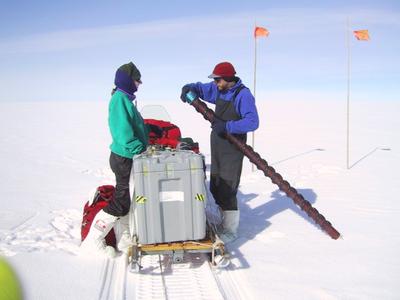
Once at the site we unloaded all the gear.
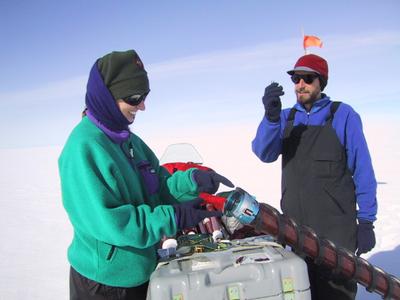
Eric explains how the coring device works. The blue tip is the actual cutting mechanism.
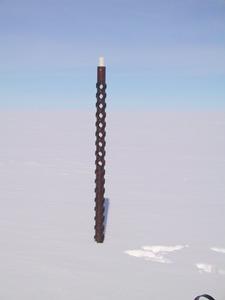
Preparing to drill. First we rinsed the drill by drilling it in and out of the snow once. We wanted to make sure it had no contaminates on it, like dust from the bag it was in.
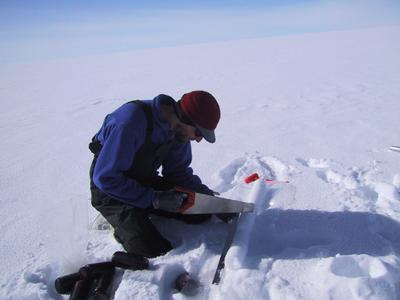
After the first core was lifted out of the hole, Eric sliced it into pieces to fit in bottles to take home to melt.
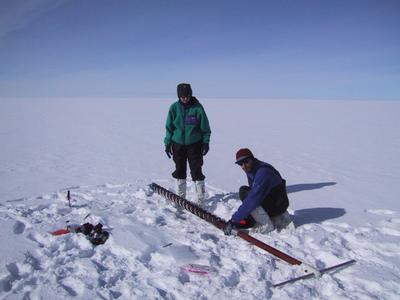
For the next meter of core we needed to extend our drill.

Once we lifted the core out of the snow we bagged it to travel back to the USA where Eric and Meredith will analyze it.
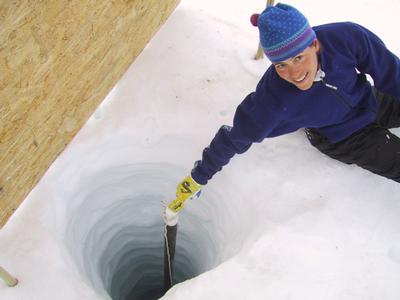
This is the hole where the drill is stuck - it is 27 feet down. I am touching the top of the drill extension.
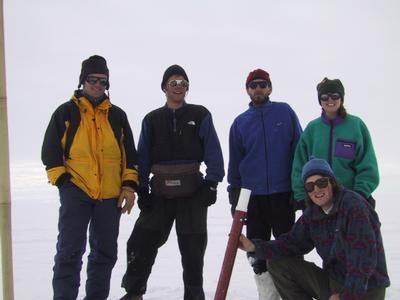
The drill rescue team, with the last piece of drill that Ted pulled out.
Contact the TEA in the field at
.
If you cannot connect through your browser, copy the
TEA's e-mail address in the "To:" line of
your favorite e-mail package.
|
